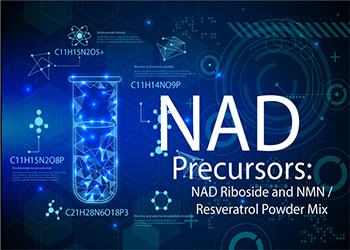

Nicotinamide mononucleotide (NMN) is a nucleotide that is well known for its role as an intermediate of nicotinamide adenine dinucleotide (NAD+) biosynthesis.
Two pathways are mainly followed in case of a eukaryotic human—one is through the salvage pathway using nicotinamide while the other follows phosphorylation of nicotinamide riboside.
Due to the unavailability of a suitable transporter, NMN enters inside the mammalian cell in the form of nicotinamide riboside followed by its subsequent conversion to NMN and NAD+.
This particular molecule has demonstrated several beneficial pharmacological activities in preclinical studies, which suggest its potential therapeutic use.
Mostly mediated by its involvement in NAD+ biosynthesis, the pharmacological activities of NMN include its role in :
Nicotinamide mononucleotide (NMN) is a type of bioactive nucleotide which is naturally formed by the reaction between a phosphate group and a nucleoside containing ribose and nicotinamide.

Not long ago, this molecule was only known for its activity as an intermediate in nicotinamide adenine dinucleotide (NAD+) biosynthesis.
Recently, preclinical studies have demonstrated diversified pharmacological activities of NMN in cardiac and cerebral ischemia, Alzheimer’s disease, diet- and age-induced type 2 diabetes, and obesity, all of which are linked up to the deficiency of NAD+ [6,7,8]. Camacho-Pereira et al. have shown that an increased level of NAD+ consuming enzymes e.g., NAD+ dependent acetylase (Sirtuins), poly ADP-ribose polymerase (PARP), NADase (CD38) contribute to the decline of NAD+ with age [9]. In mammalian cells, CD38, a type of cell surface NADase enzyme, causes breakdown of NAD+ to form nicotinamide and (cyclic-)ADP-ribose [10]. On the other hand, expenditure of NAD+ helps PARP to produce branched ADP-ribose polymers that help in DNA repairing. Another group of NAD+ consuming enzymes, sirtuins (SIRT 1-7) performs different functions by consuming NAD+. Apart from deacetylation, which is the most common NAD+ mediated function of sirtuins, other functions like desuccinylase, demalonylase, lipoamidase, and deglutarylase enzymatic activity are noteworthy that help in the cellular adaptation of energy deficit and improvement of metabolic function. Administration of NMN can compensate for the deficiency of NAD+ caused by these NAD+ consuming enzymes.


NMN shares similar properties like other NAD+ precursors- nicotinamide riboside (NR), nicotinic acid, and nicotinamide. Unlike NMN, nicotinic acid, and nicotinamide have several disadvantages in terms of their therapeutic application. Nicotinamide may cause hepatotoxicity or flushing, while a recent preclinical study suggests that it resides in the rat body for a shorter period of time compared to NMN. Niacin or nicotinic acid is associated with adverse effects like cutaneous flushing when administered as an immediate release formulation whereas the sustained release formulations may cause hepatotoxicity. Among the NAD+ precursors, NR and NMN are exceptions as fewer unfavorable side effects have been reported for these two metabolites. Moreover, nicotinamide riboside is also orally bioavailable like NMN. Considering these, NMN could be proposed as a preferable therapeutic option that can be supported by several ongoing clinical trials.
NAD+ is synthesized by three different pathways in mammalian cells-
Biosynthetic pathway of nicotinamide mononucleotide in mammalian cells.
References :
1. Bieganowski P., Brenner C. Discoveries of nicotinamide riboside as a nutrient and conserved NRK genes establish a Preiss-Handler independent route to NAD+ in fungi and humans. Cell. 2004;117:495–502. doi: 10.1016/S0092-8674(04)00416-7. [PubMed] [CrossRef] [Google Scholar]
2. Pubchem Nicotinamide Mononucleotide|C11H15N2O8P—PubChem. [(accessed on 1 January 2019)]; Available online: https://pubchem.ncbi.nlm.nih.gov/compound/nicotinamide_mononucleotide.
3. Mills K.F., Yoshida S., Stein L.R., Grozio A., Kubota S., Sasaki Y., Redpath P., Migaud M.E., Apte R.S., Uchida K., et al. Long-Term Administration of Nicotinamide Mononucleotide Mitigates Age-Associated Physiological Decline in Mice. Cell Metab. 2016;24:795–806. doi: 10.1016/j.cmet.2016.09.013. [PMC free article] [PubMed] [CrossRef] [Google Scholar]
4. Huang N., Sorci L., Zhang X., Brautigam C.A., Li X., Raffaelli N., Magni G., Grishin N.V., Osterman A.L., Zhang H. Bifunctional NMN Adenylyltransferase/ADP-Ribose Pyrophosphatase: Structure and Function in Bacterial NAD Metabolism. Structure. 2008;16:196–209. doi: 10.1016/j.str.2007.11.017. [PMC free article] [PubMed] [CrossRef] [Google Scholar]
5. Berger F., Lau C., Dahlmann M., Ziegler M. Subcellular Compartmentation and Differential Catalytic Properties of the Three Human Nicotinamide Mononucleotide Adenylyltransferase Isoforms. J. Biol. Chem. 2005;280:36334–36341. doi: 10.1074/jbc.M508660200. [PubMed] [CrossRef] [Google Scholar]
6. Yoshino J., Mills K.F., Yoon M.J., Imai S. Nicotinamide mononucleotide, a key NAD(+) intermediate, treats the pathophysiology of diet- and age-induced diabetes in mice. Cell Metab. 2011;14:528–536. doi: 10.1016/j.cmet.2011.08.014. [PMC free article] [PubMed] [CrossRef] [Google Scholar]
7. Yamamoto T., Byun J., Zhai P., Ikeda Y., Oka S., Sadoshima J. Nicotinamide Mononucleotide, an Intermediate of NAD+ Synthesis, Protects the Heart from Ischemia and Reperfusion. PLoS ONE. 2014;9:e98972. doi: 10.1371/journal.pone.0098972. [PMC free article] [PubMed] [CrossRef] [Google Scholar]
8. Long A.N., Owens K., Schlappal A.E., Kristian T., Fishman P.S., Schuh R.A. Effect of nicotinamide mononucleotide on brain mitochondrial respiratory deficits in an Alzheimer’s disease-relevant murine model. BMC Neurol. 2015;15:19. doi: 10.1186/s12883-015-0272-x. [PMC free article] [PubMed] [CrossRef] [Google Scholar]
Watch Dr. Golding talk on Integrative and Anti-Aging Medicine.
Sign up for our newsletter to find out more about the exciting world of integrative medicine
